Vault (gymnastics)
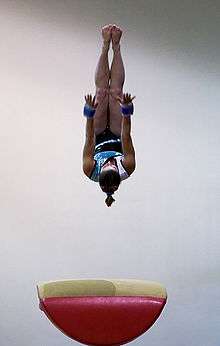
The vault is an artistic gymnastics apparatus on which gymnasts perform, as well as the skill performed using that apparatus. Vaulting is also the action of performing a vault. Both male and female gymnasts perform the vault. The English abbreviation for the event in gymnastics scoring is VT
The apparatus
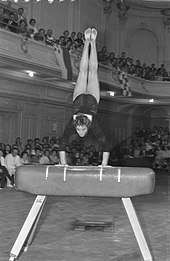
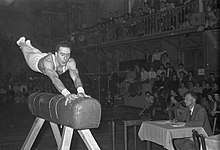
Early forms of the vault were invented by German Friedrich Ludwig Jahn. The apparatus itself originated as a "horse", much like the pommel horse but without the handles; it was sometimes known as the vaulting horse. The horse was set up with its long dimension perpendicular to the run for women, and parallel for men.[1] The vaulting horse was the apparatus used in the Olympics for over a century, beginning with the Men's vault in the first modern Olympics and ending with the Gymnastics at the 2000 Summer Olympics.
The horse has been blamed for several serious accidents over the years. In 1988, American Julissa Gomez was paralyzed in a vaulting accident; she died from complications from her injuries three years later.[2] During warmups at the 1998 Goodwill Games, Chinese gymnast Sang Lan fell and suffered paralysis from a cervical-spine injury.[3] In a series of crashes when the horse's height was set too low at the 2000 Olympics, gymnasts either rammed into the horse's front end, or had bad landings after having problems with their hand placements during push-off.[4]
Following the accident in 1988 and compounded by the ones in 1998 and 2000, International Gymnastics Federation (FIG) re-evaluated and changed the apparatus, citing both safety reasons and the desire to facilitate more impressive acrobatics.[1] The 2001 World Artistic Gymnastics Championships were the first international competition to make use of the "vaulting table", an apparatus made by Dutch gymnastics equipment company Janssen-Fritsen since the mid-1990s. It features a flat, larger, and more cushioned surface almost parallel to the floor, which slopes downward at the end closest to the springboard; gymnasts nicknamed it the "tongue";[1] it appears to be somewhat safer than the old apparatus.[5]
In 2007, Dutch junior gymnast Imke Glas was seriously injured after a fall on a vault.[6]
Dimensions
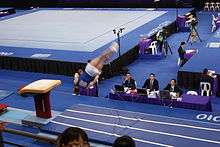
Routines
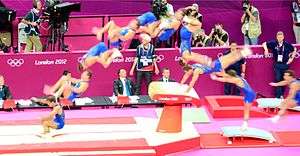
To perform a vault, the gymnast runs down a runway (the run), which is usually padded or carpeted. They hurdle onto a springboard and spring onto the vault with their hands (the preflight or first flight, and block). For vaults in the Yurchenko family, the gymnast will put their hands onto a mat that is placed before the springboard, round-off onto the board, and do a back handspring onto the vault. The off-flight may be as simple as leaping over the apparatus or as complicated as executing several twists and turns in the air. The gymnast then lands on the mat on the other side of the apparatus.
Scoring and rules
Gymnasts are expected to land cleanly, with no hops or steps, and within a set landing zone on the landing mat.[9][10] They must also demonstrate good technique and execution in the actual vault. Falling or stepping on landing incurs deduction, as will lack of height off the table, or distance from the table.[10][11]
Gymnasts (both male and female) show one vault in Qualification, Team Final, and All Around Final. If the gymnast wishes to qualify for vault apparatus finals, they must perform a second vault during qualifications. [10][12] In the Apparatus Finals gymnasts must also show two vaults.[10][12] For men, the two vaults must be from different element groups,[12] while women must show two vaults with different repulsion from the vault table.[10]
Apparatus specific rules
Yurchenko-style vaults must be performed with a safety collar placed around the springboard. If the collar is not used, the vault is considered invalid and the gymnast will receive a score of zero.[10][11]
Every vault is assigned a specific number; this number is displayed on a board or electronic screen before the gymnast begins. Gymnasts will be penalized if they fail to show the number of their intended vault, though there is no penalty if the vault ends up being different (e.g., not performing enough twists).[10][12]
If a female gymnast balks, for example stops in the middle of the runway or breaks her run before touching the springboard, no deductions are taken. The gymnast is given thirty seconds to return to the end of the runway and make a second attempt at the vault. If, however, the gymnast touches any portion of the springboard or vault itself, she receives a score of zero and may not make another attempt.[10] Ekaterina Kramarenko touched the vault and was given a zero during the team final at the 2007 World Championship. A male gymnast receives a score of 0 if he does not vault once he starts running.[11] Both male and female gymnasts receive a score of 0 if they fail to land on their feet first.[10][11]
Receiving spotting assistance from a coach, or not touching the vault table will result in a score of 0.[10][11] Vaulting before the judge has signaled the gymnast can vault once also resulted in a score of 0; this deduction has since been removed. An example of this would be at the 2008 Summer Olympic Games to Anna Pavlova during the Vault event final on her second vault.
Judging and scoring
Because the vault is completed so quickly it helps if there are cameras to play back in slow motion if they are unsure or if all the judges have a wide range of scores. It is the head judges' job to make sure all the scores are within a certain range, usually 0.2 point range difference. Judges look through four main phases: the pre-flight, support, after-flight, and landing. The overall vault of a gymnast should have power and speed, while being explosive and precise as possible.[13]
A woman's competition score is the combined average score of the two vaults she performs. Scoring has become very different in these past years. No event is scored out of ten. The new system was designed in 2005. The judges evaluate the projected difficulty of the routine and the actual skills executed to determine the final score. The projected difficulty is increased with every skill included. Each skill has its own value; the harder the skill the higher the start value. The execution is out of 10.0, looking at the form, height, length, and the landing.[13] Then in 2009, FIG made some changes to put less emphasis on the difficulty and reduce the amount of skills required, making the gymnasts focus harder on perfect execution of the vault.[14]
Vault families
Vault styles are broken into various groups. The group a vault style fits into is determined by the action performed during the vaulting movement.
Vault groups (men)There are five vault categories for men:
|
Vault groups (women)There are five vault categories for women:
|
In the USA Program, women level four, five, or six do front handsprings on vault whereas men do not compete the skill until level six. Women level three do handstand flatbacks on vault opposed to men who perform a straight jump at level four and a front tuck at level five onto stacked mats. In both programs level seven all the way to elite can perform a variety of vaults.
See also
References
- 1 2 3 What's With That Weird New Vault?, an August 2004 "Explainer" article from Slate
- ↑ Rebecca Seal, "Tales from the vaults", Guardian Unlimited December 4, 2005
- ↑ "Smiling Sang Lan" Xinhua News Agency, August 29, 2003
- ↑ "Vault mixup could have cost gymnast medal", ESPN, September 28, 2000
- ↑ "Vault: Everything You Need to know about Vault". Retrieved 2009-10-04.
- ↑ "EenVandaag: Het wonder Imke Glas" (in Dutch). 2008-07-08. Retrieved 2009-10-04.
- 1 2 3 4 "Apparatus Norms". FIG. p. II/21. Archived from the original (PDF) on 2011-12-19. Retrieved 2009-10-04.
- 1 2 3 4 5 6 "Apparatus Norms". FIG. p. II/43. Archived from the original (PDF) on 2011-12-19. Retrieved 2009-10-04.
- ↑ "MAG Code of Points 2009-2012". FIG. p. 85. Archived from the original (PDF) on 2009-10-01. Retrieved 2009-10-04.
- 1 2 3 4 5 6 7 8 9 10 "WAG Code of Points 2009-2012". FIG. pp. 22–23. Archived from the original (PDF) on 2011-12-19. Retrieved 2009-10-04.
- 1 2 3 4 5 "MAG Code of Points 2009-2012". FIG. pp. 87–88. Archived from the original (PDF) on 2009-10-01. Retrieved 2009-10-04.
- 1 2 3 4 "MAG Code of Points 2009-2012". FIG. p. 86. Archived from the original (PDF) on 2009-10-01. Retrieved 2009-10-04.
- 1 2 "Women's Artistic". Gymnastics Ontario.
- ↑ "Olympic Gymnastics:Women's Gymnastics Rules and Judging".
External links
| Wikimedia Commons has media related to Vault (gymnastics). |
- Apparatus Norms at the FIG website
- Vaulting horse
- Description of gymnastics technique by animation